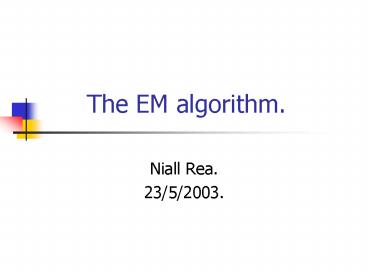The EM algorithm' PowerPoint PPT Presentation
1 / 24
Title: The EM algorithm'
1
The EM algorithm.
- Niall Rea.
- 23/5/2003.
2
Tutorial Outline.
- Introduction
- Why
- Origins.
- EM from fundamentals.
- EM for line fitting.
3
Introduction
- Estimate model parameters from incomplete /
missing data. - Optimisation technique.
- Iterative 2 step algorithm
- Expectation Expected value of complete data log
likelihood. - Maximization Maximise the expectation
expression. - Applications
- Motion segmentation, colour segmentation.
4
Introduction Origins 1/2
- MLE technique.
- Density function
- Data set
- Resulting density
- MLE problem
Incomplete data likelihood expression
5
Introduction Origins 2/2
- If simple distribution Easy
- Set
- Solve for and
- But if distribution more difficult - EM
6
EM from fundamentals 1/7
- General method for MLE when data set contains
missing variables / incomplete data. - Term in data present / missing
- Simplify likelihood function. e.g. Hidden
variables in HMM or mixture densities. - Assume observed data generated by
distribution. - Introduce incomplete data
- Define a new joint density function
7
EM from fundamentals 2/7
- New likelihood function
- Justification Consider finding ML Mixture
density parameters. Digression - Define probabilistic model
- M component densities with M mixing coefficients.
8
EM from fundamentals 3/7
- Incomplete data LL expression for density from
data
Log of sum. Difficult to optimise. Introduce
hidden variable whose value indicates which
component density generated which data item
i.e.
9
EM from fundamentals 4/7
- For each ,
- If is known, complete LL given by
- Problem unknown, can assume r.v. since
unknown, random governed by underlying
distribution
10
EM from fundamentals 5/7
- First step - Expectation Define the auxiliary
function - Find E-value of complete-data L.L. w.r.t
- given and current parameter set.
Current parameter set.
Random variable governed by
Parameter set to be optimised.
11
EM from fundamentals 7/7
- Maximisation step
- Maximisation of expectation
- Iterate process until convergence.
- Will always converge to local optimum
- c.f. M.L from incomplete data via the EM
algorithm Dempster, Laird, Rubin.
12
EM for line fitting 1/12
- Mixture estimation problem.
- Observation model
- Assume normally distributed errors
- Estimate line parameters and assignment of each
datapoint to the process that generated it. - EM intuition - Need to know one to estimate the
other. - EM structure
- Random parameter assignment for line models
- Iterate until convergence
- E-step assign points to model that results in
best fit - M step update parameters of model using points
assigned to it.
13
EM for line fitting 2/12
- E-step
- Define , the squared residual difference
between observation at point and predictions of
each model. - Compute the posterior
- Probability of assignment of each point to
particular model.
14
EM for line fitting 3/12
- M-Step For a given line , minimize
15
EM for line fitting 4/12
- Solving for for each line
16
EM for line fitting 5/12
17
EM for line fitting 6/12
18
EM for line fitting 7/12
19
EM for line fitting 8/12
20
EM for line fitting 9/12
21
EM for line fitting 10/12
22
EM for line fitting 11/12
23
EM for line fitting 12/12
24
Questions?

